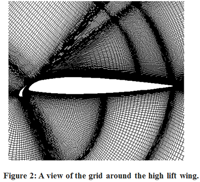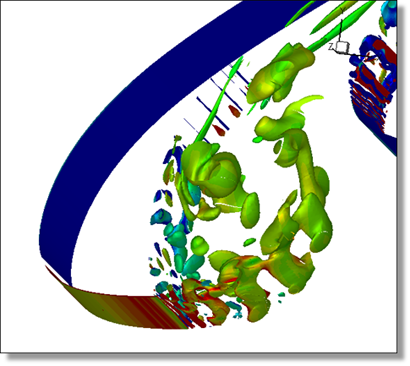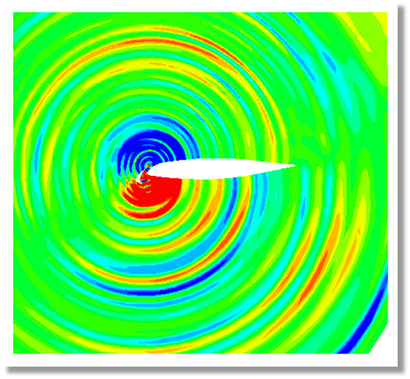Numerical simulations were performed to investigate the generation and farfield propagation of the slat noise generated by a high-lift wing model. A numerical approach was developed that combines nearfield flow computation with an integral radiation model to predict the farfield acoustic signals. A time domain impedance boundary condition was implemented to simulate the effect of the liner material directly. The noise generation was calculated using large-eddy simulation (LES) with a 6th-order accuracy spatial scheme. The calculated noise sources were then used to drive the acoustic perturbation equations (APE) to simulate the noise propagation and the attenuation by acoustic liners. The farfield acoustic signals were calculated by solving the Ffowcs Williams and Hawkings equation. Results show that attenuation is achieved by the acoustic liner treatment.

The significant contribution of the flows around the leading edge slat on the wing of a commercial aircraft to the airframe noise during approach and landing motivates this research project to identify the mechanisms of leading edge slat noise and passively control these acoustic sources.
Several flow phenomena take place due to the separated flow in the slat cove region and its interaction with the surrounding flow such as, low-speed recirculation flow, free shear layer, and ejections of large-scale structures merging with the slat wake. Other important phenomena can also exist, such as, the interaction of the slat wake with the wing boundary layer, referred to as the confluent boundary layer, and slat trailing edge vortex shedding. All of these may cause the noise generation. To understand the physics and mechanisms behind these phenomena and to find a way to reduce the slat noise, accurate simulations of the complex unsteadiness flow of the high-lift wing are needed.
To develop and apply computational aeroacoustic methods using the SotonCAA code to reveal the mechanism of the slat noise generation and demonstrate the feasibility of controlling the slat noise using acoustic liners.

Figure 3: Q iso surface colored with z-vorticity near the slat cove.

Figure 4: Pressure perturbation around the high lift wing
The calculated results show that the three-dimensional unsteady flow in the slat cove region is associated with broadband noise sources. The flow near the reattachment point has large fluctuation values and contributes to the broadband noise generation. The LES calculated noise sources were used to drive the acoustic perturbation equations. The source driven APE results agree well with that of LES in terms of farfield directivity and sound pressure level. The broadband noise attenuation effect of the acoustic liner treatment in the slat/main element gap has been investigated by applying a non-optimised acoustic liner to the APE calculated acoustic field. The maximum attenuation for the slat lined case is 1.9 dB at 2.0kHz and the maximum attenuation for the slat and main element both lined case is 2.4 dB at 2.0 kHz.